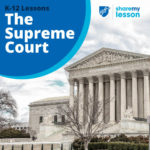In a 19th Amendment video, produced by the Administrative Office of the U.S. Courts for use in classrooms, courtrooms, and the distance-learning space, an unlikely connection is made between two rights activists from different eras. Suffragette Virginia Minor and Vietnam war protester Mary Beth Tinker were separated by 100 years, but their passions came together in the legal history of the nation and of St. Louis, where they each worked through the courts to make social change. Both cases were decided – with different outcomes – by the Supreme Court of the United States.
Balancing Religious Freedom and Government Interests
This lesson explores the Supreme Court case Tandon v. Newsom (2021) regarding religious liberty.Throughout the COVID-19 pandemic, the state government of California along with many of its county governments placed restrictions on gatherings of people. One of their regulations had the effect of preventing more than three households gathering together at a time for any in-home prayer and Bible studies. Plaintiffs sued the state, arguing that these restrictions violated the First Amendment since many secular businesses were allowed to have more than three households of people within it at any time, and that therefore religion was being specifically discriminated against. The Supreme Court recently released a per curiam (unsigned) decision concerning the constitutionality of these regulations.
Dialogue on the Fourteenth Amendment
The American Bar Association Dialogue program provides lawyers, judges and teachers with the resources they need to engage students and community members in a discussion of fundamental American legal principles and civic traditions. This Dialogue on the Fourteenth Amendment is composed of three parts:
Part 1: Equal Protection and Civil Rights – Participants discuss the equal protection clause of the 14th Amendment and consider how Congress, through federal legislation, has worked to help realize its constitutional promise.
Part 2: Incorporating the Bill of Rights examines the concept of incorporation. Using a case study of Gitlow v. New York, this section provides a guide to how courts have applied the Bill of Rights, selectively, to the states using the 14th Amendment.
Part 3: Ensuring Equality and Liberty explores how the 14th Amendment has been interpreted by courts to protect fundamental freedoms, including individuals’ right to marry.
Redistricting & Gerrymandering Lesson Plan
In this lesson, students will learn how state legislatures and governors can manipulate the redistricting process to gain an advantage for their party in the U.S. House of Representatives and state legislatures. Students will learn what constitutes gerrymandering and the typical types of gerrymandering used. Students will role play state legislators and collaborate to draw both gerrymandered and not gerrymandered districts. Students will consider the foundational redistricting case Baker v. Carr (1962) and classify arguments made in the case. In addition, students will evaluate the proper role of the Supreme Court in state redistricting cases.
What is the Judicial Branch?
This lesson exposes students to the judicial branch and the power of judicial review. They will read about an actual Supreme Court case, Torcaso v. Watkins, to see how the judicial branch used its power of judicial review to strike down an unconstitutional state law.
Contested Ballots: You Be the Judge
This lesson uses the example of the 2008 contested Senate election between Al Franken and Norm Coleman in Minnesota to discuss contested elections, counting votes, and recount laws. Looks at recount laws in your own state.
Arizona Legislature v. Arizona Independent Redistricting Commission (2015)
Did Proposition 106 violate the Elections Clause of the US Constitution by removing congressional districting power from the state legislature? The case summary provides the facts, and the Supreme Court’s answer to this question.
Our Rights
The book Our Rights, written by David J. Bodenhamer, uses historical case studies to explore the rights in the Constitution. Supreme Court cases are used to demonstrate how a right received its modern interpretation, how the right applies today, and how courts and other interpreters seek to balance this right with important societal concerns such as public safety. The complete book or individual chapters can be downloaded.
The Appointment of Sandra Day O’Connor
The U.S. Constitution grants the President the power to appoint people to a variety of government positions. These appointments require careful thought and consideration since the people can have a great impact on the lives of many Americans during that President’s term. Some appointments need even greater thought and consideration, and those are to the federal judicial system and more importantly, to the Supreme Court of the United States. Justices of the Supreme Court (and other federal courts) serve lifetime appointments. Their rulings as they interpret the Constitution, and other situations as outlined in Article III of the Constitution, can have far-reaching effects for generations. With this awesome power to appoint comes an equally awesome responsibility to make sure that the individuals are the best people for the job. In this lesson, students will examine the appointment of Supreme Court Justice Sandra Day O’Connor, who was also the first female Justice. Students will examine the process by which a President makes the selection and the steps that lead to that person being confirmed by the Senate (or not).
The Supreme Court: Balancing the Branches

The nine, lifetime-appointed justices on the Supreme Court play a huge role in our lives through interpreting the application of laws passed by the United States Congress and state legislatures. The Share My Lesson team has curated a collection of free lesson plans and activities to support teachers in educating their students about the structure and role of the Supreme Court.